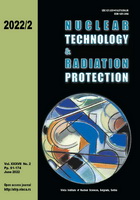
ANALYTICAL COMPUTATION TECHNIQUE FOR CALCULATION THE EFFECTIVE GEOMETRICAL SOLID ANGLE AND THE EFFICIENCY OF CUBIC SCINTILLATION CRYSTAL WITH SIDE CYLINDRICAL HOLE
Pages: 91-102
Authors: Mohamed S. Badawi and Abouzeid A. ThabetAbstract
In the gamma-ray spectroscopy field, the radiometric examination for small quantities of natural samples is extremely significant. Therefore, the gamma-ray spectrometry calibration process must be prepared with good precision for several energies, matrices of sources or samples, and source-to-detector shapes. This manuscript considers a new uncomplicated analytical computation technique to calculate the effective geometrical solid angle and the efficiency of cubic scintillation crystal with a side cylindrical hole. The computations can be done by using a simple method, with a few essential limitations, that describes radioactive point sources located inside the side cylindrical hole and a high-efficiency cubic NaI(Tl) detector, come together with a low background as well. The technique stands on a trouble-free solid angle analytical formula for the detection system, using an accurate relation for the detector cavity, united with rough formulas controlling the interactions in the gamma-ray source and the materials introduced in between the source and the gamma-ray spectrometry. This new technique is not restricted to certain sources, because several source shapes can correspond to a homogeneous huge number of point sources and the detector geometry can be represented as a set of border points. The technique simply can be useful to obtain the full-energy peak efficiency in the future, challenging developments for low-energy gamma-ray spectroscopy.
Key words: analytical computation technique, cubic scintillation crystal with side cylindrical hole, geometrical solid angle, detector efficiency
FULL PAPER IN PDF FORMAT (1.62 MB)
